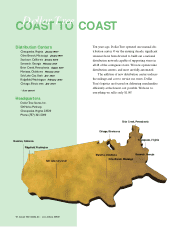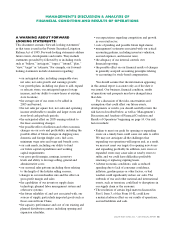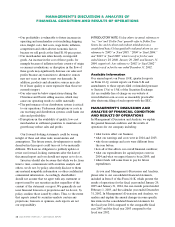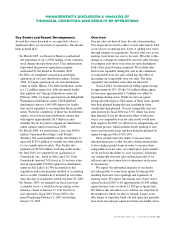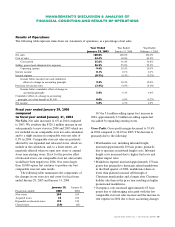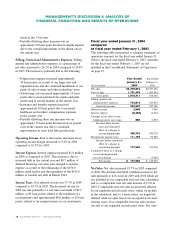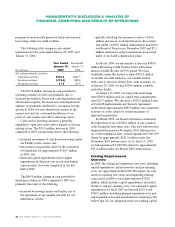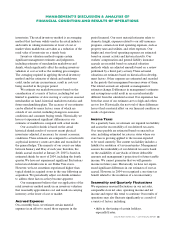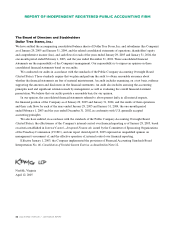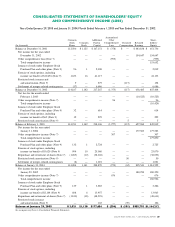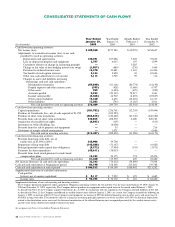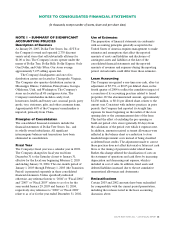Dollar Tree 2004 Annual Report Download - page 26
Download and view the complete annual report
Please find page 26 of the 2004 Dollar Tree annual report below. You can navigate through the pages in the report by either clicking on the pages listed below, or by using the keyword search tool below to find specific information within the annual report.
22 DOLLAR TREE STORES, INC. • 2004 ANNUAL REPORT
of credit is renewable annually. The letter of credit and
reimbursement agreement requires that we maintain
specified financial ratios and restricts our ability to
pay cash dividends.
Commitments
Letters of Credit and Surety Bonds. Effective March 12,
2001, we entered into a Letter of Credit Reimbursement
and Security Agreement, which provides $125.0 million
for letters of credit, which are generally issued for the
routine purchase of imported merchandise. Approximately
$88.9 million was committed to letters of credit at
January 29, 2005. We also have letters of credit or surety
bonds outstanding for our revenue bond financing, our
insurance programs and certain utility payment
obligations at some of our stores.
Freight Contracts. We have contracted outbound freight
services from various carriers with contracts expiring
through January 2007. The total amount of these
commitments is approximately $35.5 million.
Technology Assets. We have commitments totaling
approximately $5.8 million to primarily purchase store
technology assets for our stores during 2005.
Derivative Financial Instruments
We are party to two interest rate swaps, which allow us
to manage the risk associated with interest rate fluctuations
on the demand revenue bonds and a portion of our
revolving credit facility. The swaps are based on notional
amounts of $19.0 million and $25.0 million. Under the
$19.0 million agreement, as amended, we pay interest
to the bank that provided the swap at a fixed rate. In
exchange, the financial institution pays us at a variable-
interest rate, which is similar to the rate on the demand
revenue bonds. The variable-interest rate on the interest
rate swap is set monthly. No payments are made by
either party under the swap for monthly periods with an
established interest rate greater than a predetermined rate
(the knock-out rate). The swap may be canceled by the
bank or us and settled for the fair value of the swap as
determined by market rates.
The $25.0 million interest rate swap agreement is
used to manage the risk associated with interest rate
fluctuations on a portion of our revolving credit facility.
Under this agreement, we pay interest to a financial
institution at a fixed rate of 5.43%. In exchange, the
financial institution pays us at a variable-interest rate,
which approximates the floating rate on the debt,
excluding the credit spread. The interest rate on the swap
is subject to adjustment monthly. The swap is effective
through March 2006, but it may be canceled by the bank
or us and settled for the fair value of the swap as
determined by market rates.
Because of the knock-out provision in the $19.0
million swap, changes in the fair value of that swap are
recorded in earnings. Changes in fair value on our $25.0
million interest rate swap are recorded as a component
of “accumulated other comprehensive income”in the
consolidated balance sheets because the swap qualifies
for hedge accounting treatment in accordance with
Statement of Financial Accounting Standards No. 133, as
amended by Statement of Financial Accounting Standards
No. 138. The amounts recorded in accumulated other
comprehensive income are subsequently reclassified into
earnings in the same period in which the related interest
affects earnings.
For more information on the interest rate swaps, see
“Quantitative and Qualitative Disclosures About Market
Risk – Interest Rate Risk.”
Critical Accounting Policies
The preparation of financial statements requires the use
of estimates. Certain of our estimates require a high level
of judgment and have the potential to have a material
effect on the financial statements if actual results vary
significantly from those estimates. Following is a
discussion of the estimates that we consider critical.
Inventory Valuation
As discussed in Note 1 to the Consolidated Financial
Statements, inventories at the distribution centers are
stated at the lower of cost or market with cost determined
on a weighted-average basis. Cost is assigned to store
inventories using the retail inventory method on a
weighted-average basis. Under the retail inventory
method, the valuation of inventories at cost and the
resulting gross margins are computed by applying a
calculated cost-to-retail ratio to the retail value of
MANAGEMENT’S DISCUSSION & ANALYSIS OF
FINANCIAL CONDITION AND RESULTS OF OPERATIONS


